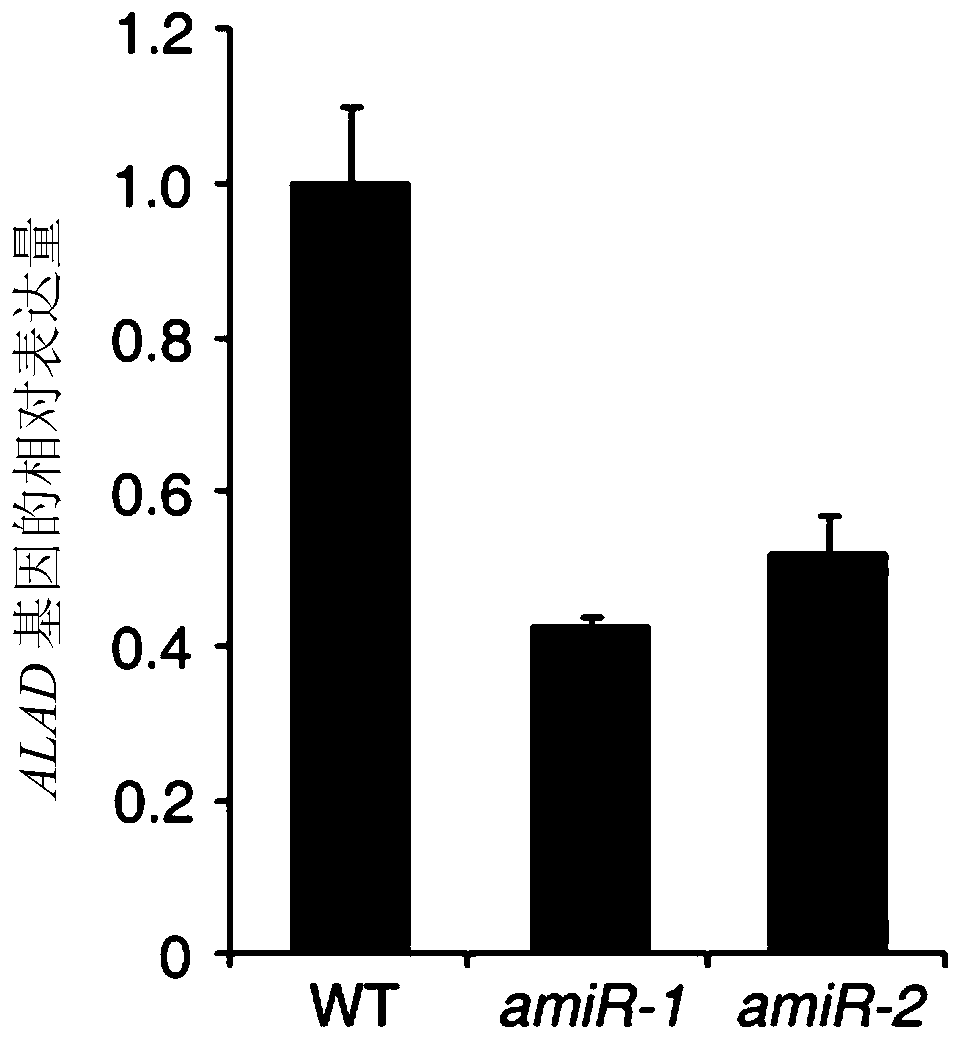Chlorophyll synthesis related protein, coding gene and application thereof
A technology that encodes genes and chlorophyll, which is applied in the fields of application, genetic engineering, plant gene improvement, etc., can solve problems such as complex regulatory networks of chlorophyll synthesis and degradation, and achieve the effect of improving synthesis ability
- Summary
- Abstract
- Description
- Claims
- Application Information
AI Technical Summary
Problems solved by technology
Method used
Image
Examples
Embodiment 1
[0075] Example 1. Acquisition of chlorophyll synthesis-related gene ALAD
[0076] The total RNA of wild-type Arabidopsis thaliana (Col ecotype) was extracted, reverse-transcribed into cDNA, and used as a template for PCR amplification using the following primers 1 and 2.
[0077] Primer 1: 5'- CCATGG TC-ATGGCTACTACACCCCATC-3' (the underlined part is the recognition sequence of NcoI, and the sequence after - is the 1st-18th position of sequence 2);
[0078] Primer 2: 5'- AGATCT CCGCTTCTCGCCGCCACAAACAAGTAGCAG-3' (the underlined part is the recognition sequence of BglII, and the following sequence is the reverse complementary sequence of the 1262-1290th position of Sequence 2).
[0079] After the reaction, agarose gel electrophoresis was performed. The results showed that the target band with a size of about 1293bp was amplified. Further, after the PCR product was recovered, it was sent to the sample for sequencing, and the results showed that the sequence of the obtained P...
Embodiment 2
[0080] Embodiment 2, the acquisition of ALAD-amiR transgenic plants
[0081] 1. Construction of recombinant expression vector pDS1301-ALAD-amiRNA
[0082] 1. Primer design
[0083] According to the precursor mir319a sequence contained in the pRS300 vector, the following primers ALAD-F and ALAD-R were designed. In addition, according to the ALAD gene shown in Sequence 2 in the sequence listing, four oligonucleotide chains were predicted by Weigelworld software: ALAD1, ALAD2, ALAD3 and ALAD4, which were used to design ArtificialRNAiALAD.
[0084] ALAD-F: 5'-CTGCAAGGCGATTAAGTTGGGTAAC-3';
[0085] ALAD-R: 5'-GCGGATAACAATTTCACACAGGAAACAG-3'.
[0086] ALAD1: 5'-GATAACGATACTGTTTACCCCACTCTCTCTTTTGTATTCC-3';
[0087] ALAD2: 5'-GAGTGGGGTAAACAGTATCGTTATCAAAGAGAATCAATGA-3';
[0088] ALAD3: 5'-GAGTAGGGTAAACAGAATCGTTTTTCACAGGTCGTGATATG-3';
[0089] ALAD4: 5'-GAAAACGATTCTGTTTACCCTACTCTACATATATTCCT-3'.
[0090] Among them, ArtificialRNAiALAD "5'-TAACGATACTGTTTACCCCAC-3'" interacts with...
Embodiment 3
[0116] Example 3, Functional Identification of ALAD-amiR Transgenic Plants
[0117] Positive T3 generation ALAD-amiR transgenic plants (amiR-1 and amiR-2 strains) identified in Example 2, Arabidopsis plants transformed into pDS1301 empty vector, and wild-type Arabidopsis (No-0 ecotype) for the experimental material.
PUM
 Login to View More
Login to View More Abstract
Description
Claims
Application Information
 Login to View More
Login to View More - R&D Engineer
- R&D Manager
- IP Professional
- Industry Leading Data Capabilities
- Powerful AI technology
- Patent DNA Extraction
Browse by: Latest US Patents, China's latest patents, Technical Efficacy Thesaurus, Application Domain, Technology Topic, Popular Technical Reports.
© 2024 PatSnap. All rights reserved.Legal|Privacy policy|Modern Slavery Act Transparency Statement|Sitemap|About US| Contact US: help@patsnap.com










